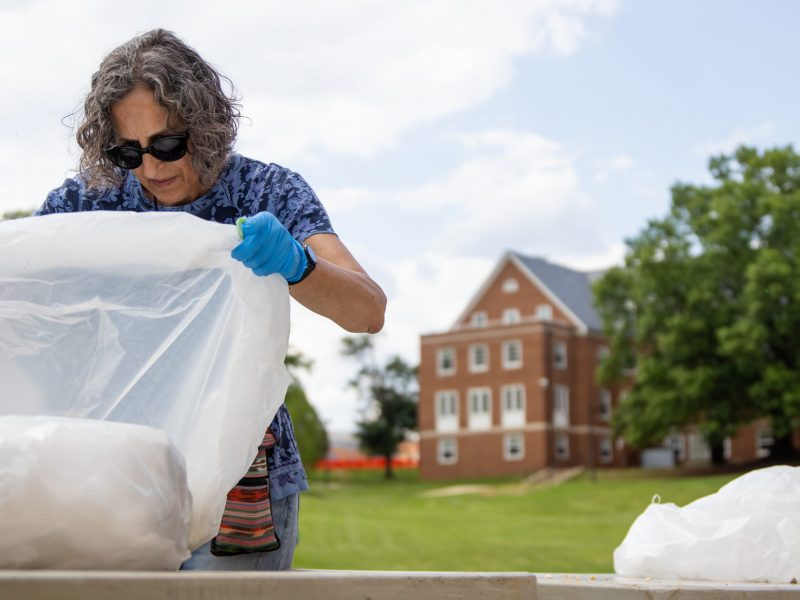
Seniors Soshana and Eliezer Kolatch, who are Jewish, got married this winter after dating for seven years. The Orthodox Jewish community, like many orthodox or conservative religions, puts a strong emphasis on marriage and family.
Shoshana and Eliezer Kolatch’s lives resemble that of the ideal newlyweds. They cook lunch for one another, drive each other places and attend Sabbath services together.
Even their home is that of the ideal newlyweds: The cozy and clean apartment is filled with wedding gifts and has photos hanging on the wall. However, the Kolatchs lead their quintessential newlywed life across the street from weekly house parties and rowdy college students – because that’s what they are: a pair of college students.
Shoshana, a senior history major, and Eliezer, a senior linguistics major, took the plunge into married life this winter just before the semester started, as did many other Orthodox Jewish students for whom winter is a sort of engagement season, according to Hillel’s Rabbi Elli Fischer.
Winter is a popular time for both weddings and engagements in the campus Jewish community because couples like to have time to plan parties and meet each other’s families. There were at least eight engagements or weddings this winter and six weddings last summer.
The Orthodox Jewish community, as many orthodox or conservative religions, has a strong emphasis on marriage and family that leads many college students to marry at an early age. This year has seen an especially large number of engagements, Fisher said, mainly because of the growth in the Jewish community.
The Kolatchs, who are a semester shy of graduating, decided to marry while still in college because they didn’t want to experience multiple life transitions at once, Shoshana said.
Marielle Simon, a junior education major and Orthodox Jew, said there definitely is an expectation to marry early, and students react differently to the pressure.
“Once you get here, you see everyone’s going out with people, and everybody’s getting engaged, and it’s more like, ‘Wow, I need to start looking,” Marielle said. “Once a transfer student comes in, all the girls are checking him out.”
College is the perfect time to meet someone because of the size of the Orthodox community on the campus, she said. Often Orthodox students who get engaged while in college wait until right after they graduate to get married.
For junior criminology major Eve Reingold, the pressure to get married hasn’t sunk in yet; she’s still getting used to engagement party-hopping. These parties are typically held in the Commons apartments because of the large concentration of Orthodox students in the buildings.
Fischer attributes the growth of the Orthodox community on the campus to Maryland’s reputation outside the state and the large size of the Orthodox community in general. “Once it reaches a critical mass, it generates its own momentum,” Fischer said of the campus community in an e-mail.
Marrying and having children is obligatory in traditional Jewish law because it ensures the continuation of mankind, Fischer said. There are also some restrictions that come with dating and engagements, such as a prohibition of pre-marital sex or, in some cases, the prohibition of all physical contact. Orthodox Jews who avoid touching are called shomer negiah.
“A hug, a kiss, something that is not part of lovemaking, but is no doubt affectionate, even holding hands or hands around the shoulder, that’s considered affectionate contact; that’s forbidden on the Rabbinic level,” Fischer said.
There is a movement toward greater stringency in observing Jewish law because of the growth of casual sex and relaxed sexual mores. There are at least 30 shomer negiah students within the 300 to 500 of the Orthodox campus community, Fischer said. It isn’t obvious who is and who isn’t shomer negiah, but pictures from engagement parties are telling signs. Often a couple will be standing next to each other and not touching.
It is difficult to stay single for long if someone chooses to be shomer negiah, so people tend to get married younger, Fischer said.
Being shomer negiah is attractive for young students because it allows a relationship to develop along non-sexual lines. Jews are also forbidden to marry someone they aren’t physically attracted to.
“It has to be there, that component of physical attraction, but it has to be more than that, too,” Fischer said.
Emily Lennon, a fall graduate, and Marc Lennon, a 2005 spring graduate, dated for three years before they married in January. They both had decided independently to be shomer negiah before they started dating.
“It was very difficult, because you want to find ways to show your affection with someone, and it was hard with just words and no physical contact,” Emily said. “It’s hard when you see other couples holding hands and you’re not able to, but it was worth it.”
Emily wasn’t raised in an Orthodox family, so it was difficult at first for her family to understand her decision.
“My parents thought we were crazy, like the fact we’d sleep in different rooms when he came to my house,” she said. “But they’ve been spoiled that they never had to worry … on one hand, [they thought], ‘What’s wrong with them, that’s weird,’ on the other, ‘Wow, that’s really respectable.'”
She has not experienced discrimination within the community for her decision.
“I don’t think it’s an issue,” Emily said. “People are understanding both ways,” she said.
What is considered affectionate can vary among different cultures. A kiss on the cheek in some European cultures is considered non-affectionate, and in the United States a handshake is permissible because “it’s seen as the quintessential non-affectionate act,” Fischer said.
The context of physical contact is also important, as there are certain situations where touching is allowed. For instance, individuals can perform CPR in the event of an emergency.
If a person breaks the laws against affectionate contact, it is a personal matter between them and God, Fischer said.
As far as Fischer knows, the marriages between young people typically work out. While he doesn’t know if divorce rates are higher or lower among young couples, the divorce rate in the larger Orthodox community is low.
There is a tradeoff to marrying young, however, Fischer said, and, like everything, it comes with some negatives. For Lennon, an early marriage seemed daunting because of her inexperience.
“There’s the worry of ‘I’m still a kid, I’ve never lived on my own – before, I didn’t know what it takes to budget, I don’t know how to run a home – I just know my life as a student and a child in my parents’ home.’ It’s tough to make that decision [to marry young],” Lennon said.
Contact reporter Elahe Izadi at newsdesk@dbk.umd.edu.



